Limitations of Fair Value Accounting in Financial Statements
VerifiedAdded on 2020/03/16
|6
|1230
|64
Report
AI Summary
This report critically examines fair value accounting, as introduced by AASB 13 in Australian accounting standards, and its limitations in providing decision-useful information to end-users of financial statements. It explores the concept of fair value, which aims to provide an accurate market-based valuation of assets and liabilities, contrasting it with historical cost accounting. The report highlights significant limitations, including the potential for increased volatility in financial statements, which can lead to misleading financial reports and hinder accurate market price prediction. It discusses how fair value accounting's reliance on assumptions and market conditions can contribute to financial crises and challenges in understanding disclosures. The report concludes that, despite its aims, fair value accounting may not always support the decision-making process of end-users effectively.
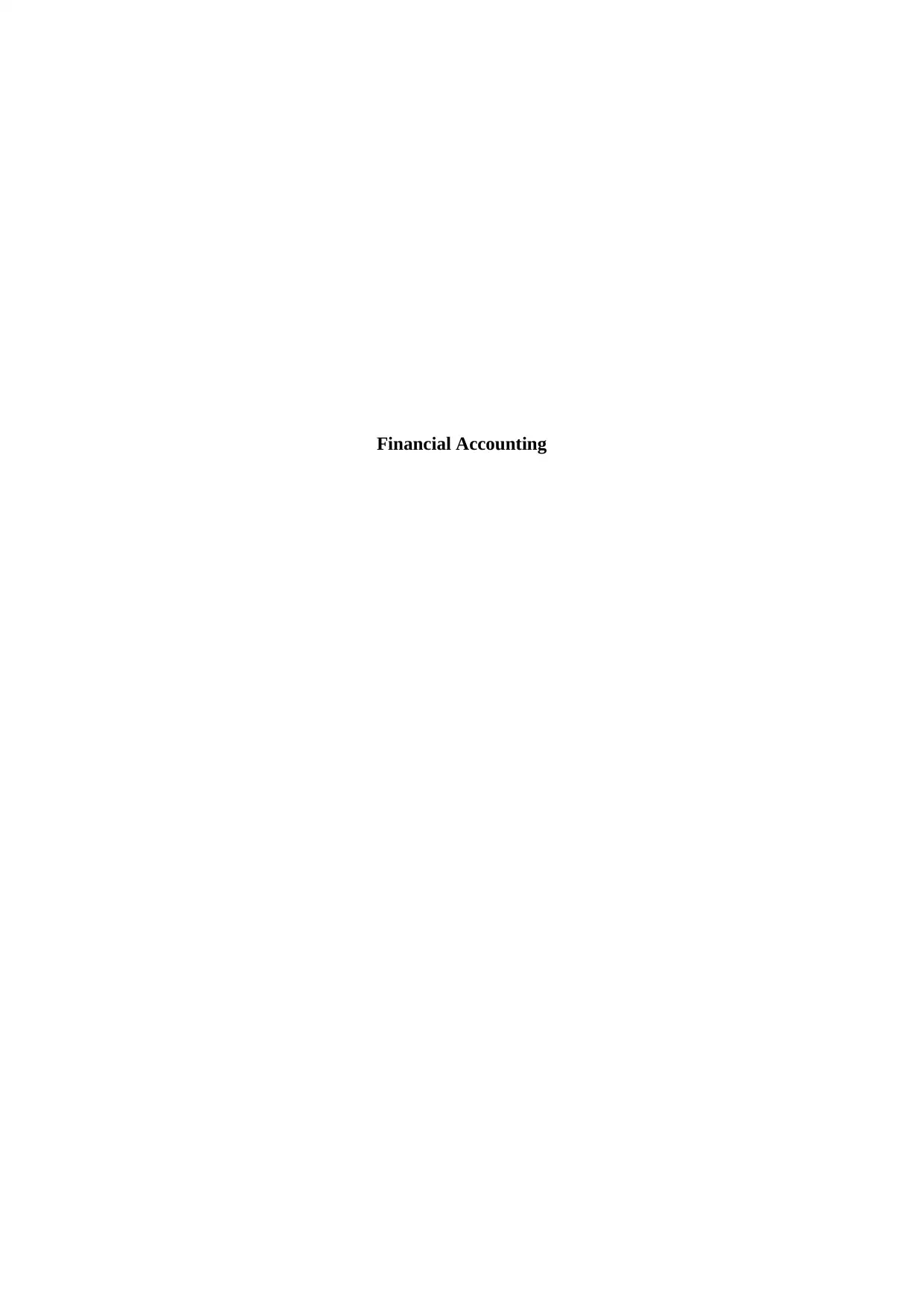
Financial Accounting
Paraphrase This Document
Need a fresh take? Get an instant paraphrase of this document with our AI Paraphraser
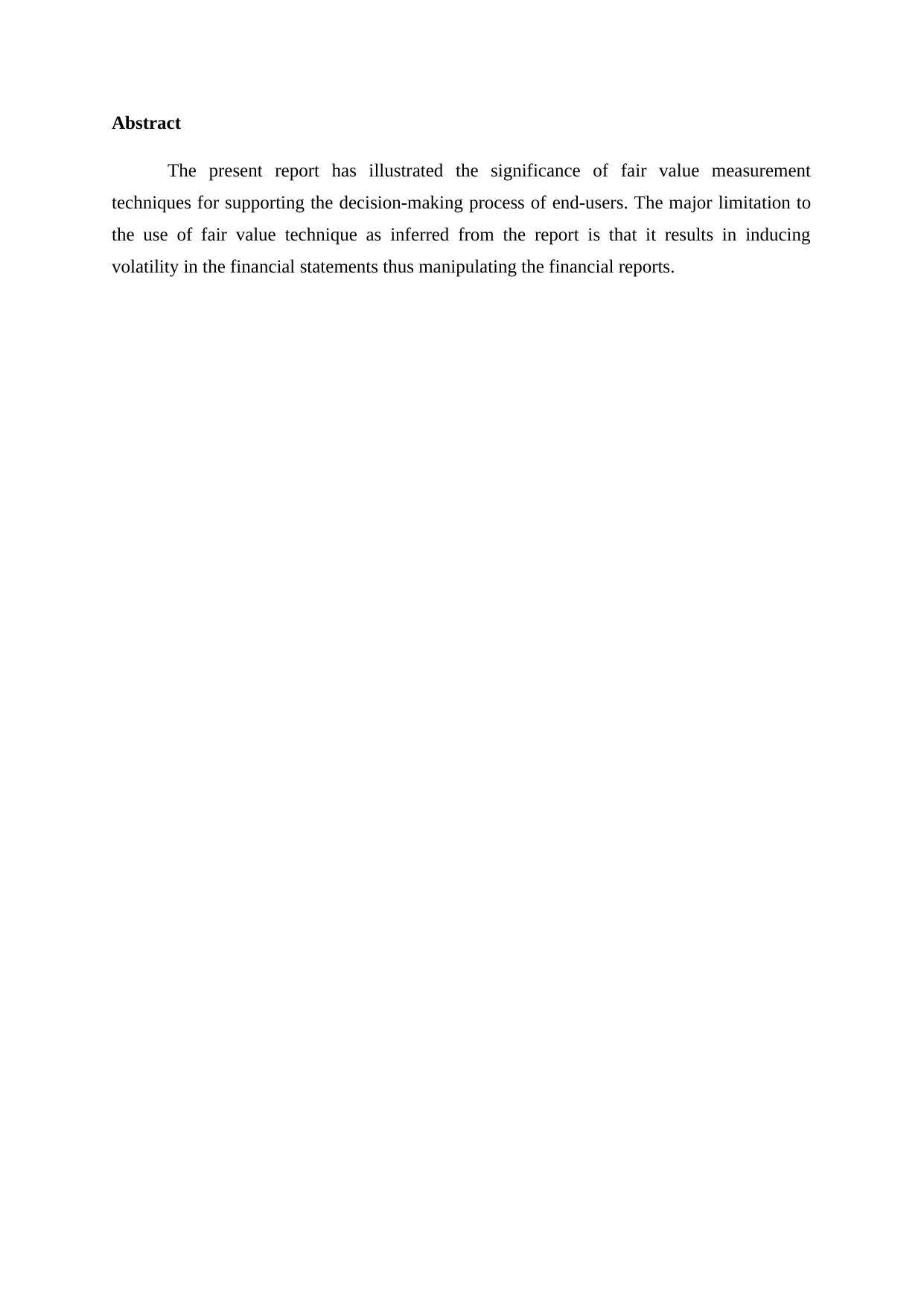
Abstract
The present report has illustrated the significance of fair value measurement
techniques for supporting the decision-making process of end-users. The major limitation to
the use of fair value technique as inferred from the report is that it results in inducing
volatility in the financial statements thus manipulating the financial reports.
The present report has illustrated the significance of fair value measurement
techniques for supporting the decision-making process of end-users. The major limitation to
the use of fair value technique as inferred from the report is that it results in inducing
volatility in the financial statements thus manipulating the financial reports.
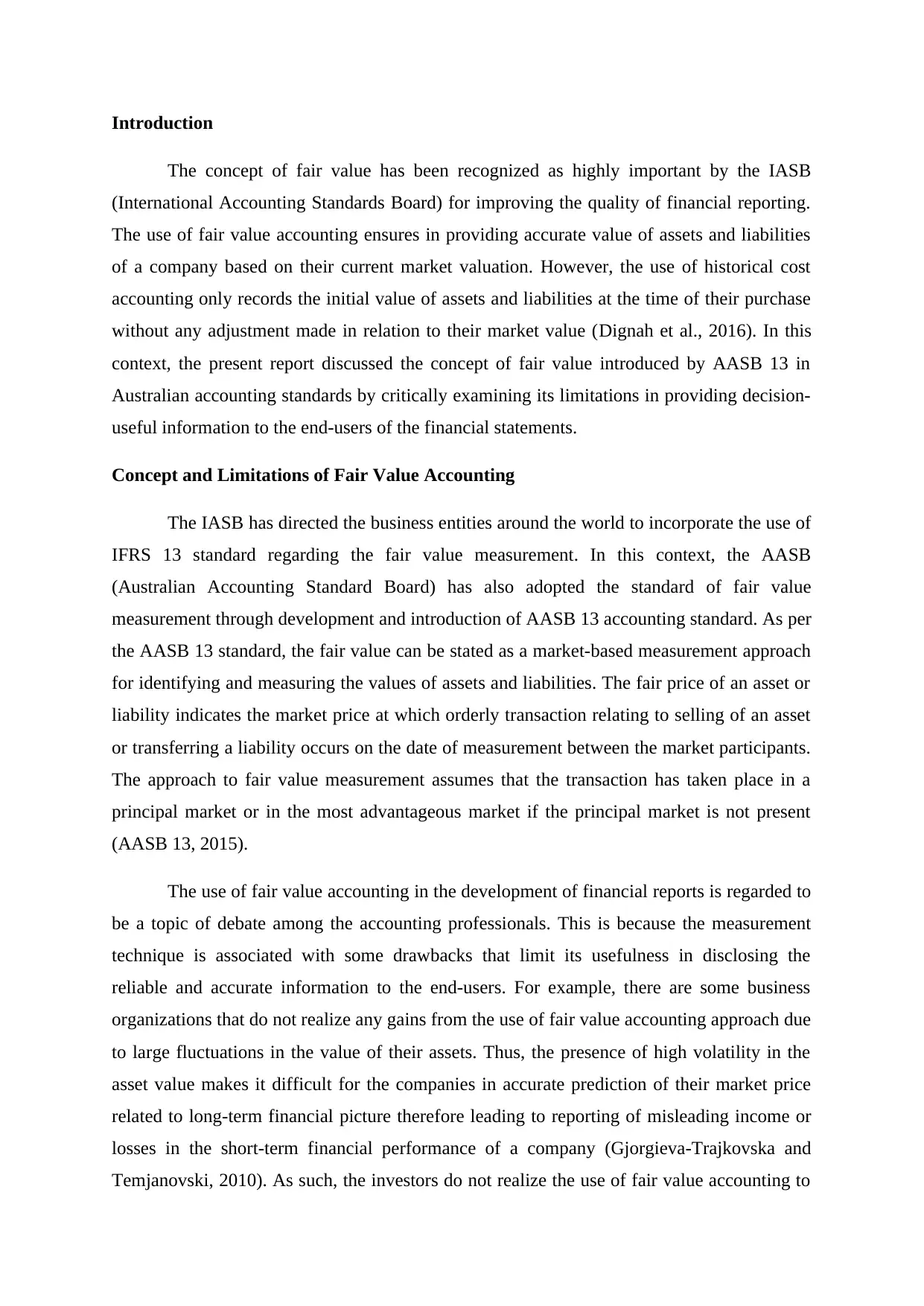
Introduction
The concept of fair value has been recognized as highly important by the IASB
(International Accounting Standards Board) for improving the quality of financial reporting.
The use of fair value accounting ensures in providing accurate value of assets and liabilities
of a company based on their current market valuation. However, the use of historical cost
accounting only records the initial value of assets and liabilities at the time of their purchase
without any adjustment made in relation to their market value (Dignah et al., 2016). In this
context, the present report discussed the concept of fair value introduced by AASB 13 in
Australian accounting standards by critically examining its limitations in providing decision-
useful information to the end-users of the financial statements.
Concept and Limitations of Fair Value Accounting
The IASB has directed the business entities around the world to incorporate the use of
IFRS 13 standard regarding the fair value measurement. In this context, the AASB
(Australian Accounting Standard Board) has also adopted the standard of fair value
measurement through development and introduction of AASB 13 accounting standard. As per
the AASB 13 standard, the fair value can be stated as a market-based measurement approach
for identifying and measuring the values of assets and liabilities. The fair price of an asset or
liability indicates the market price at which orderly transaction relating to selling of an asset
or transferring a liability occurs on the date of measurement between the market participants.
The approach to fair value measurement assumes that the transaction has taken place in a
principal market or in the most advantageous market if the principal market is not present
(AASB 13, 2015).
The use of fair value accounting in the development of financial reports is regarded to
be a topic of debate among the accounting professionals. This is because the measurement
technique is associated with some drawbacks that limit its usefulness in disclosing the
reliable and accurate information to the end-users. For example, there are some business
organizations that do not realize any gains from the use of fair value accounting approach due
to large fluctuations in the value of their assets. Thus, the presence of high volatility in the
asset value makes it difficult for the companies in accurate prediction of their market price
related to long-term financial picture therefore leading to reporting of misleading income or
losses in the short-term financial performance of a company (Gjorgieva-Trajkovska and
Temjanovski, 2010). As such, the investors do not realize the use of fair value accounting to
The concept of fair value has been recognized as highly important by the IASB
(International Accounting Standards Board) for improving the quality of financial reporting.
The use of fair value accounting ensures in providing accurate value of assets and liabilities
of a company based on their current market valuation. However, the use of historical cost
accounting only records the initial value of assets and liabilities at the time of their purchase
without any adjustment made in relation to their market value (Dignah et al., 2016). In this
context, the present report discussed the concept of fair value introduced by AASB 13 in
Australian accounting standards by critically examining its limitations in providing decision-
useful information to the end-users of the financial statements.
Concept and Limitations of Fair Value Accounting
The IASB has directed the business entities around the world to incorporate the use of
IFRS 13 standard regarding the fair value measurement. In this context, the AASB
(Australian Accounting Standard Board) has also adopted the standard of fair value
measurement through development and introduction of AASB 13 accounting standard. As per
the AASB 13 standard, the fair value can be stated as a market-based measurement approach
for identifying and measuring the values of assets and liabilities. The fair price of an asset or
liability indicates the market price at which orderly transaction relating to selling of an asset
or transferring a liability occurs on the date of measurement between the market participants.
The approach to fair value measurement assumes that the transaction has taken place in a
principal market or in the most advantageous market if the principal market is not present
(AASB 13, 2015).
The use of fair value accounting in the development of financial reports is regarded to
be a topic of debate among the accounting professionals. This is because the measurement
technique is associated with some drawbacks that limit its usefulness in disclosing the
reliable and accurate information to the end-users. For example, there are some business
organizations that do not realize any gains from the use of fair value accounting approach due
to large fluctuations in the value of their assets. Thus, the presence of high volatility in the
asset value makes it difficult for the companies in accurate prediction of their market price
related to long-term financial picture therefore leading to reporting of misleading income or
losses in the short-term financial performance of a company (Gjorgieva-Trajkovska and
Temjanovski, 2010). As such, the investors do not realize the use of fair value accounting to
⊘ This is a preview!⊘
Do you want full access?
Subscribe today to unlock all pages.

Trusted by 1+ million students worldwide
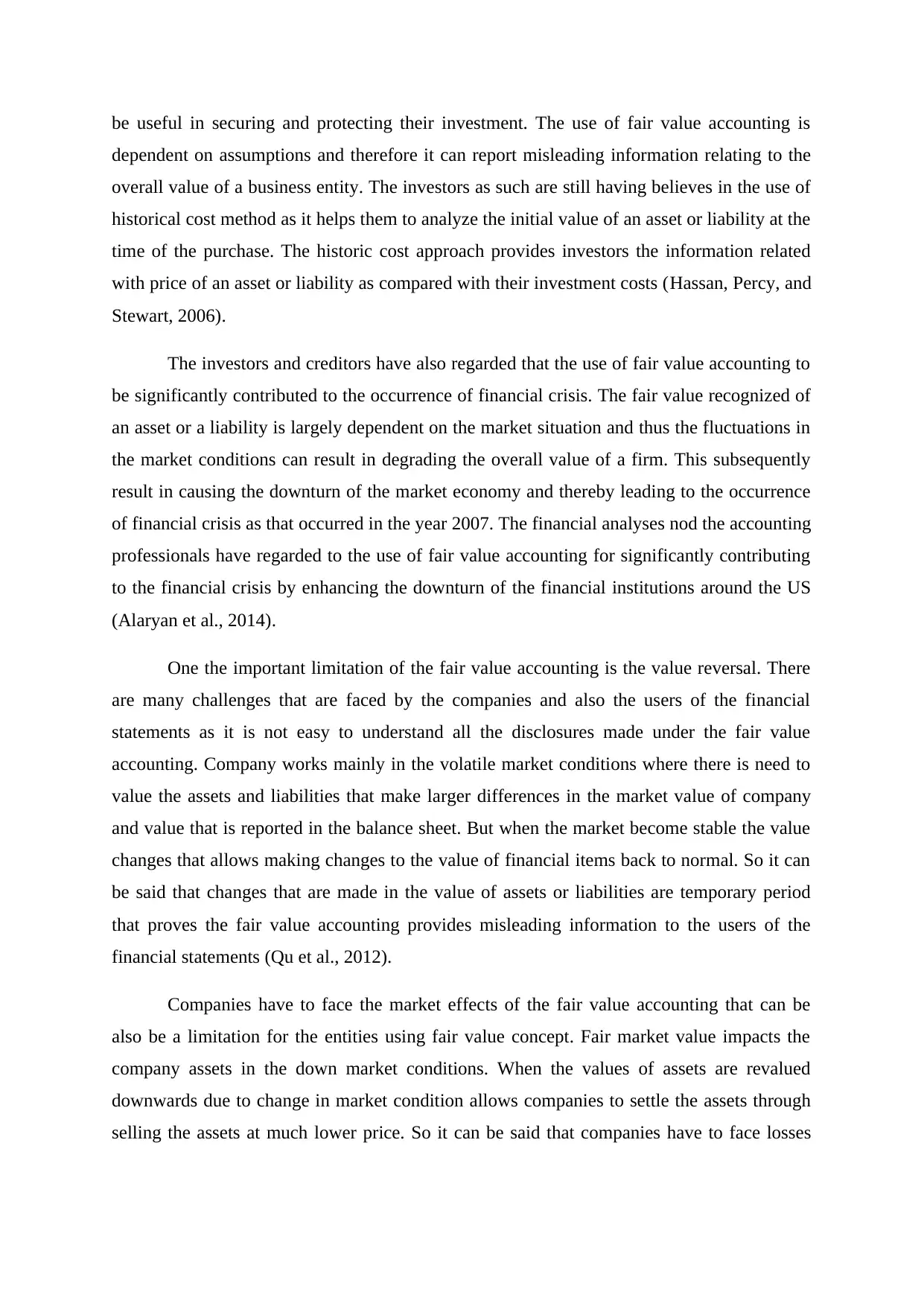
be useful in securing and protecting their investment. The use of fair value accounting is
dependent on assumptions and therefore it can report misleading information relating to the
overall value of a business entity. The investors as such are still having believes in the use of
historical cost method as it helps them to analyze the initial value of an asset or liability at the
time of the purchase. The historic cost approach provides investors the information related
with price of an asset or liability as compared with their investment costs (Hassan, Percy, and
Stewart, 2006).
The investors and creditors have also regarded that the use of fair value accounting to
be significantly contributed to the occurrence of financial crisis. The fair value recognized of
an asset or a liability is largely dependent on the market situation and thus the fluctuations in
the market conditions can result in degrading the overall value of a firm. This subsequently
result in causing the downturn of the market economy and thereby leading to the occurrence
of financial crisis as that occurred in the year 2007. The financial analyses nod the accounting
professionals have regarded to the use of fair value accounting for significantly contributing
to the financial crisis by enhancing the downturn of the financial institutions around the US
(Alaryan et al., 2014).
One the important limitation of the fair value accounting is the value reversal. There
are many challenges that are faced by the companies and also the users of the financial
statements as it is not easy to understand all the disclosures made under the fair value
accounting. Company works mainly in the volatile market conditions where there is need to
value the assets and liabilities that make larger differences in the market value of company
and value that is reported in the balance sheet. But when the market become stable the value
changes that allows making changes to the value of financial items back to normal. So it can
be said that changes that are made in the value of assets or liabilities are temporary period
that proves the fair value accounting provides misleading information to the users of the
financial statements (Qu et al., 2012).
Companies have to face the market effects of the fair value accounting that can be
also be a limitation for the entities using fair value concept. Fair market value impacts the
company assets in the down market conditions. When the values of assets are revalued
downwards due to change in market condition allows companies to settle the assets through
selling the assets at much lower price. So it can be said that companies have to face losses
dependent on assumptions and therefore it can report misleading information relating to the
overall value of a business entity. The investors as such are still having believes in the use of
historical cost method as it helps them to analyze the initial value of an asset or liability at the
time of the purchase. The historic cost approach provides investors the information related
with price of an asset or liability as compared with their investment costs (Hassan, Percy, and
Stewart, 2006).
The investors and creditors have also regarded that the use of fair value accounting to
be significantly contributed to the occurrence of financial crisis. The fair value recognized of
an asset or a liability is largely dependent on the market situation and thus the fluctuations in
the market conditions can result in degrading the overall value of a firm. This subsequently
result in causing the downturn of the market economy and thereby leading to the occurrence
of financial crisis as that occurred in the year 2007. The financial analyses nod the accounting
professionals have regarded to the use of fair value accounting for significantly contributing
to the financial crisis by enhancing the downturn of the financial institutions around the US
(Alaryan et al., 2014).
One the important limitation of the fair value accounting is the value reversal. There
are many challenges that are faced by the companies and also the users of the financial
statements as it is not easy to understand all the disclosures made under the fair value
accounting. Company works mainly in the volatile market conditions where there is need to
value the assets and liabilities that make larger differences in the market value of company
and value that is reported in the balance sheet. But when the market become stable the value
changes that allows making changes to the value of financial items back to normal. So it can
be said that changes that are made in the value of assets or liabilities are temporary period
that proves the fair value accounting provides misleading information to the users of the
financial statements (Qu et al., 2012).
Companies have to face the market effects of the fair value accounting that can be
also be a limitation for the entities using fair value concept. Fair market value impacts the
company assets in the down market conditions. When the values of assets are revalued
downwards due to change in market condition allows companies to settle the assets through
selling the assets at much lower price. So it can be said that companies have to face losses
Paraphrase This Document
Need a fresh take? Get an instant paraphrase of this document with our AI Paraphraser
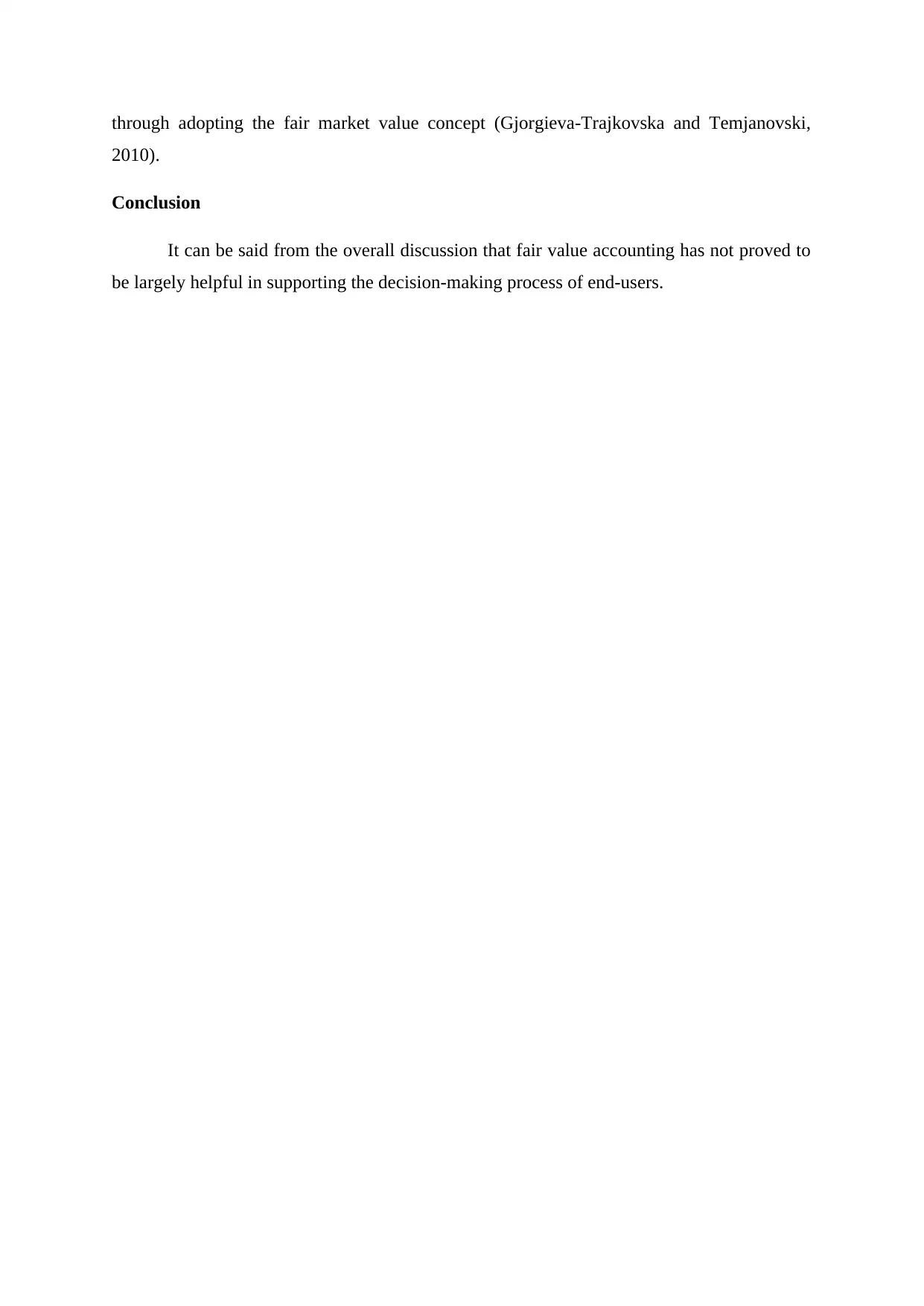
through adopting the fair market value concept (Gjorgieva-Trajkovska and Temjanovski,
2010).
Conclusion
It can be said from the overall discussion that fair value accounting has not proved to
be largely helpful in supporting the decision-making process of end-users.
2010).
Conclusion
It can be said from the overall discussion that fair value accounting has not proved to
be largely helpful in supporting the decision-making process of end-users.
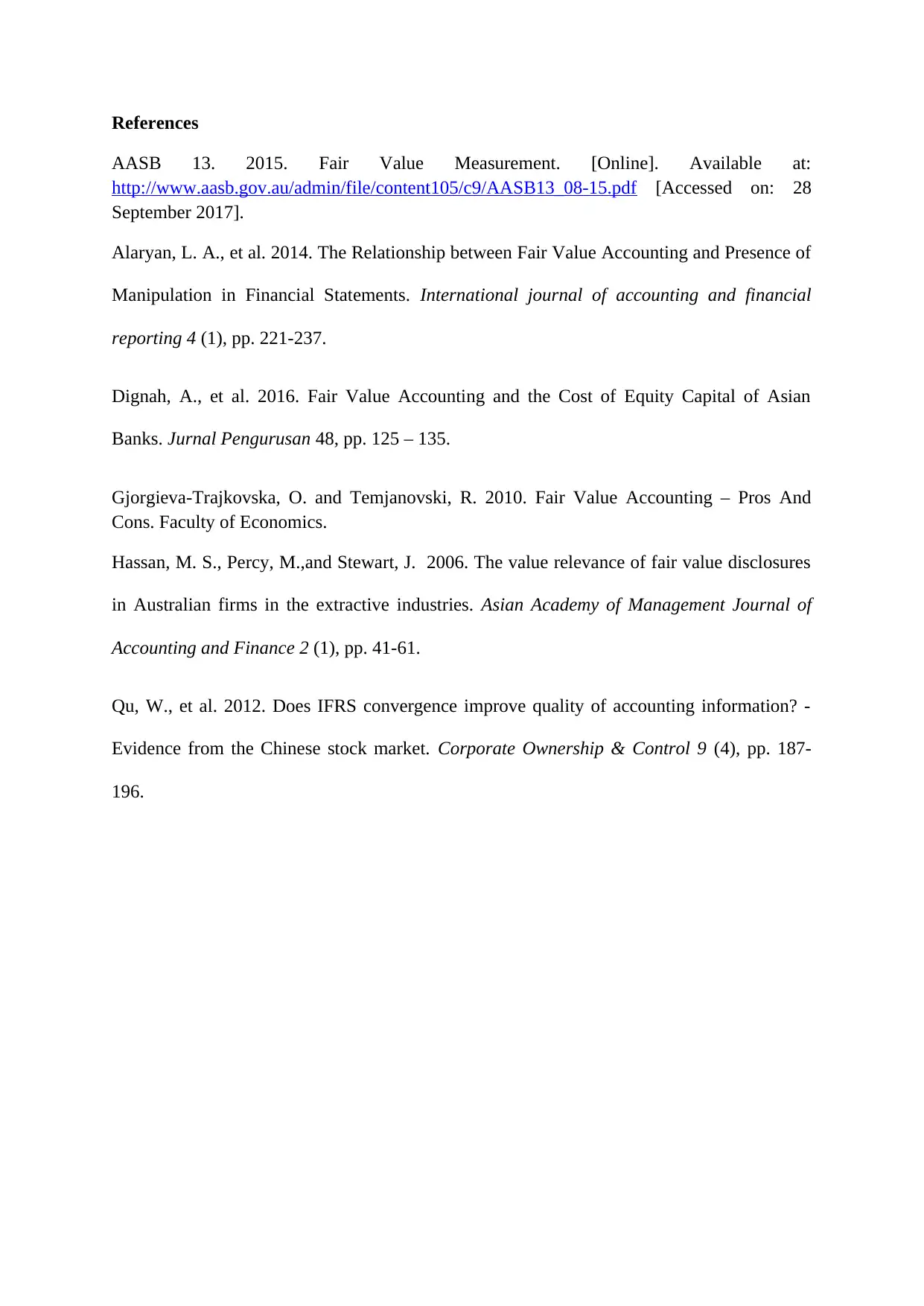
References
AASB 13. 2015. Fair Value Measurement. [Online]. Available at:
http://www.aasb.gov.au/admin/file/content105/c9/AASB13_08-15.pdf [Accessed on: 28
September 2017].
Alaryan, L. A., et al. 2014. The Relationship between Fair Value Accounting and Presence of
Manipulation in Financial Statements. International journal of accounting and financial
reporting 4 (1), pp. 221-237.
Dignah, A., et al. 2016. Fair Value Accounting and the Cost of Equity Capital of Asian
Banks. Jurnal Pengurusan 48, pp. 125 – 135.
Gjorgieva-Trajkovska, O. and Temjanovski, R. 2010. Fair Value Accounting – Pros And
Cons. Faculty of Economics.
Hassan, M. S., Percy, M.,and Stewart, J. 2006. The value relevance of fair value disclosures
in Australian firms in the extractive industries. Asian Academy of Management Journal of
Accounting and Finance 2 (1), pp. 41-61.
Qu, W., et al. 2012. Does IFRS convergence improve quality of accounting information? -
Evidence from the Chinese stock market. Corporate Ownership & Control 9 (4), pp. 187-
196.
AASB 13. 2015. Fair Value Measurement. [Online]. Available at:
http://www.aasb.gov.au/admin/file/content105/c9/AASB13_08-15.pdf [Accessed on: 28
September 2017].
Alaryan, L. A., et al. 2014. The Relationship between Fair Value Accounting and Presence of
Manipulation in Financial Statements. International journal of accounting and financial
reporting 4 (1), pp. 221-237.
Dignah, A., et al. 2016. Fair Value Accounting and the Cost of Equity Capital of Asian
Banks. Jurnal Pengurusan 48, pp. 125 – 135.
Gjorgieva-Trajkovska, O. and Temjanovski, R. 2010. Fair Value Accounting – Pros And
Cons. Faculty of Economics.
Hassan, M. S., Percy, M.,and Stewart, J. 2006. The value relevance of fair value disclosures
in Australian firms in the extractive industries. Asian Academy of Management Journal of
Accounting and Finance 2 (1), pp. 41-61.
Qu, W., et al. 2012. Does IFRS convergence improve quality of accounting information? -
Evidence from the Chinese stock market. Corporate Ownership & Control 9 (4), pp. 187-
196.
⊘ This is a preview!⊘
Do you want full access?
Subscribe today to unlock all pages.

Trusted by 1+ million students worldwide
1 out of 6
Related Documents
Your All-in-One AI-Powered Toolkit for Academic Success.
+13062052269
info@desklib.com
Available 24*7 on WhatsApp / Email
![[object Object]](/_next/static/media/star-bottom.7253800d.svg)
Unlock your academic potential
Copyright © 2020–2025 A2Z Services. All Rights Reserved. Developed and managed by ZUCOL.





